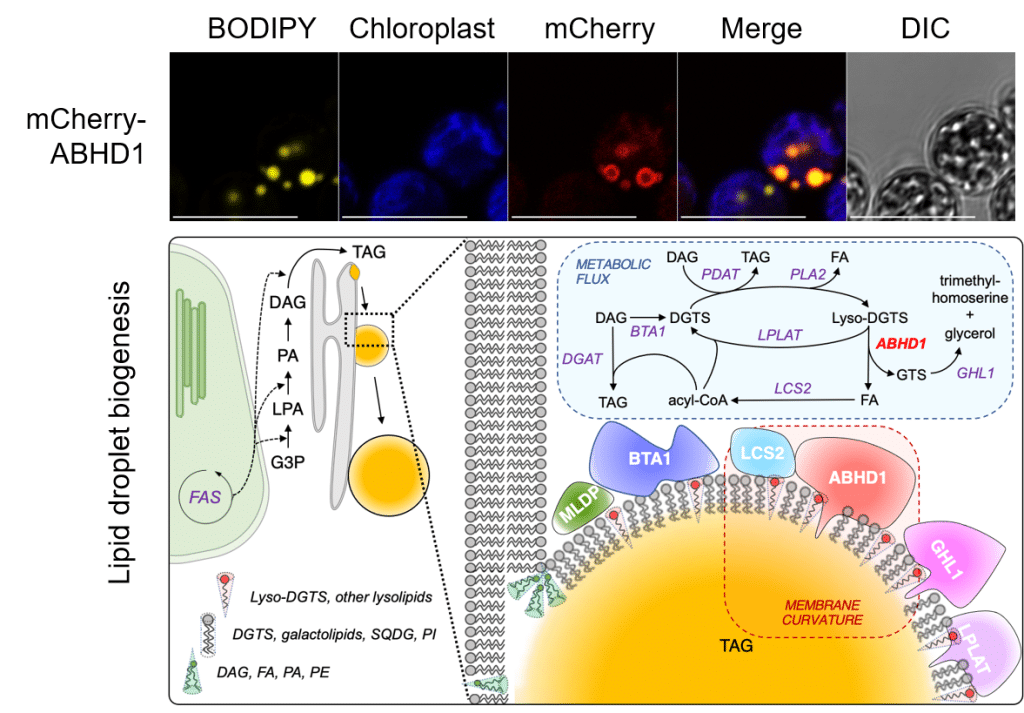Microalgae and Bioenergy
BIAM researchers have identified a key protein, ABHD1, which plays a central role in the management of lipid droplets, the cell’s energy and carbon reservoirs. In addition to deepening our understanding of fundamental cellular mechanisms, this discovery could revolutionize algae engineering by improving cellular oil content, and opening up new perspectives in biotechnology.
Energy strategy at the heart of the droplets
One of BIAM’s teams, EBMP, is exploring the full potential of microalgae for innovative biotechnological applications such as bioenergy production. Their study of the model microalga, Chlamydomonas, has revealed the life cycle of its lipid droplets, small compartments that form at the heart of cells and store energy in the form of triacylglycerols fats. They are constantly formed, renewed and recycled to help the cell meet its energy needs and adapt to fluctuations in its environment.
ABHD1, a multi-talented protein
“Our research has brought to light a protein called ABHD1 present on the surface of lipid droplets”, explains Yonghua Li-Beisson, head of the EBMP team and co-author of this discovery. The first acts as a molecular architect, facilitating droplet formation. By modifying the membrane that surrounds them, ABHD1 enables these energetic structures to develop and form efficiently.
ABHD1’s second function is as a specialized enzyme, or lipase, capable of breaking down a specific type of lipid present in the droplet membrane. This enzymatic action adjusts the composition of the droplets, optimizing their ability to store and manage energy according to the cell’s needs.
Observation of ABHD1 protein (yellow) around lipid droplets
A lever for innovation
This dual function makes ABHD1 a first of its kind, as underlined by the scientist, “This is the first example of a protein capable of fulfilling both a structural and enzymatic role in lipid droplet management.”
The interest of this discovery does not stop at understanding cellular mechanisms. Lipases like ABHD1 could be used to manipulate lipid storage in various eukaryotic organisms. These applications could prove invaluable in the fields of biotechnology, because we can use ABHD1 to increase cellular oil content for food, green chemistry and fuel purposes.
By shedding light on how lipid droplets function, this study marks a major advance in our understanding of cellular energy and carbon management, and opens up promising prospects for optimizing natural processes for scientific and industrial purposes.
Références
National Science Review. 2024 Nov. https://doi.org/10.1093/nsr/nwae398
Ismael Torres-Romero1, Bertrand Légeret1, Marie Huleux1, Damien Sorigue1, Alicia Damm2, Stéphan Cuiné1, Florian Veillet1, Carla Blot1, Sabine Brugière3, Yohann Couté3, Matthew G. Garneau4, Hari Kiran Kotapati4, Yi Xin5, Jian Xu5, Philip D. Bates4, Abdou Rachid Thiam2, Fred Beisson1, Yonghua Li-Beisson1#
Collaboration:
- Aix Marseille Univ, CEA, CNRS, Institute of Bioscience and Biotechnology of Aix Marseille, BIAM, Saint-Paul-Lez-Durance, France.
- Laboratoire de Physique de l’École Normale Supérieure, ENS, Université PSL, CNRS, Sorbonne Université, Université de Paris Cité, Paris, France
- Univ. Grenoble Alpes, INSERM, CEA, UMR BioSanté U1292, CNRS, CEA, FR2048, 38000 Grenoble, France.
- Institute of Biological Chemistry, Washington State University, Pullman, WA, USA.
- Single-Cell Center, CAS Key Laboratory of Biofuels and Shandong Key Laboratory of Energy Genetics, Qingdao Institute of Bioenergy and Bioprocess Technology, Chinese Academy of Sciences, Qingdao, Shandong 266101, China.
